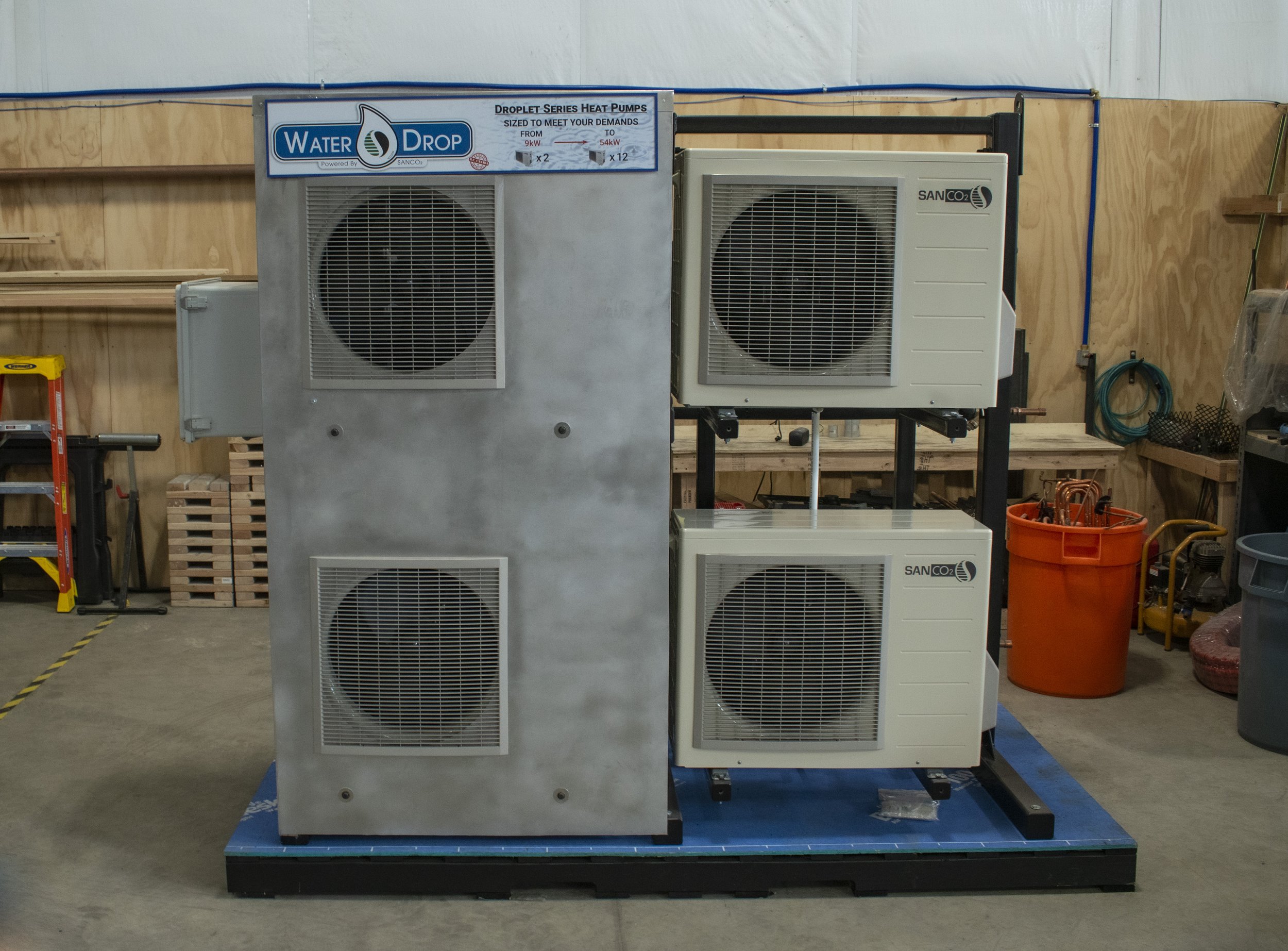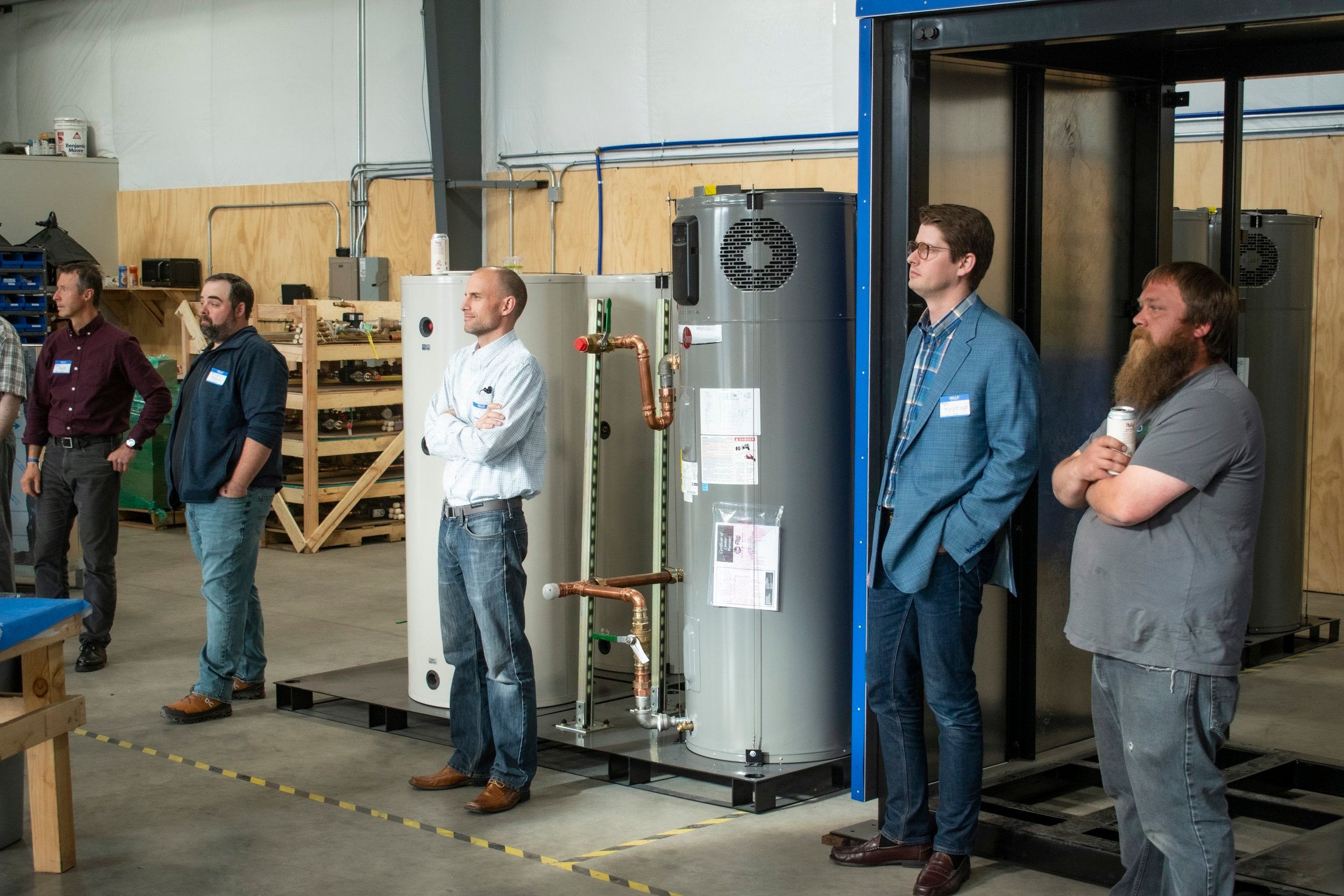A Quick "Drop-In" on WaterDrop with Small Planet Supply CEO Albert Rooks
/Small Planet Supply CEO ALBERT ROOKS
A lot’s been happening with Small Planet Supply’s WaterDrop systems. We caught up with Small Planet Supply CEO Albert Rooks to learn more about how the WaterDrop and the new Droplets evolved as well as new innovations that are in the works.
Since the WaterDrop concept was first introduced, what are some of the big events or changes that have happened?
A completed Full Size WaterDRop system
The biggest changes that have happened is that we’ve matured numerous designs, creating a good array of packages for a large spectrum of building sizes, load shapes and building needs. We started with the original package of a fully packaged central heat pump water heating plant with heat pumps, primary storage and swing tank, the temperature maintenance valve, and the building recirc pump all in one insulated package that could be dropped in and hooked up. The second phase was splitting away the heat pumps and creating a two-piece package, where heat pumps could be placed in one location and the tanks in another location.
Another the new development is the part load plants. Part load plants are an interesting development in that in new construction in some jurisdictions some the initial code demands will not be 100% electric heat pumps, but a requirement for 50%. So, you could have a hybrid system in a building like this, where there still is a gas water heater, but you’ve also built a heat pump plant, like one of our WaterDrop skids which contributes to the water load but cutting in half its fossil fuel use and carbon emissions. So that would be a part load system: You look at the entire load and you set up a system where the heat pump contributes to part of the full load.
The split energy system can also be applied to existing buildings. In many existing buildings there’s going to be a conversion from a gas boiler or another system, over to an electric heat pump system. An electric heat pump system is going to need lots of storage that these buildings won’t have. So, the two things you really need are heat pumps and a bunch of primary storage. You don’t need the swing tank and the building pump and the recirc system because the existing building may already have a suitable system. You can downgrade the use of the gas boiler, and have it fill the normal use of a swing tank which means now you just need to provide heat pumps and primary storage for it. That creates a full system. So, we designed a series of part load applications, or part load skids that are designed to fill the part load application in new construction or be a more economical way to convert existing buildings into either part-load electric heat pump or full-load electric heat pump and reuse some of the existing infrastructure. The goal is to move to 100% fossil-fuel free buildings, but this blended approach allows for thoughtful, staged decarbonization in certain areas or projects where a full-switch isn’t immediately possible.
In addition, our controls have become more mature and now we’re moving into this really interesting phase of working with load shift and creating controls that will receive a signal from the utility asking the system to stand-down for a period because there’s a grid emergency, or it’s a peak load time for the grid or to fire up and run because there is excess energy to place, or it’s the best time to use energy so let’s use that energy to convert electricity into thermal energy to store it inside that central plant.
Recently, Small Planet Supply introduced the Droplet. Can you say more about it, what it is and what would be the optimal application for using Droplets?
Droplet System cutaway
Droplets are a unique adaptation to a full WaterDrop skidded package. It’s often the case in existing buildings where there isn’t a place to put a full package because they’re big and the building has already been built and you must work with what you have. So, the Droplet gives you the ability to split the heat pumps away into a small package, place them in one location and pipe them over to the tanks which can be placed in a different location. This makes it much easier to adapt to existing buildings where you can’t set a large package up on a roof or something like that.
Space can also be an issue new construction, depending on when the design team starts designing the job and they’ve massed the building to the point where now it becomes difficult to put in a full package system. The Droplet gives the ability to set the heat pumps array in one location (in a parkade, a roof or next to the building) and then place the tanks in a mechanical room inside the building and then just connect the two. We’re able to make the Droplets match the full skidded systems in terms of heat pump capacity and then we’re able to match up the tanks and the storage system. To control some very large systems that use multiple Droplets, we’ve developed a new design that has a master control (maybe) in the mechanical room that would control (maybe) two to four Droplets, each independently.
Is there any loss in efficiency with the Droplet design versus the standard WaterDrop?
There’s no loss of efficiency; It’s a little more complex from the standpoint of installation. It requires more onsite piping which costs a little bit more, but on the flip side it’s a little more flexible in systems where you really need that flexibility to meet the space constraints of the building.
Small Planet Supply recently opened a second assembly plant in Richmond, BC. Why was the decision made to open a second plant so soon? What benefits are there to having two assembly plants instead of one?
Small Planet Supply’s Anas Patel and Saba Samim at the Richmond assembly plant.
In many cases having one assembly plant would streamline the operations and the staff associated with the operations. But, really the case in British Columbia and in the lower metro area surrounding the City of Vancouver – we could see the direction of the province as quickly moving to decarbonize new and existing buildings. The market’s very young and there is no substitute to being directly connected and in the market. In this age of manufacturing, our design – the key components are working out the design and then handing the design and the manufacturing plans and processes over to an assembly group.
We thought it was possible to set up a parallel assembly group in the lower mainland British Columbia area. This way we could really build a relationship with our distribution partner, Olympic International, their customers and engineers and just close that circle and make it easier for everyone to communicate, react and fine-tune and tailor for the market. Fortunately, to help make this make this happen, Small Planet Supply applied for and received funding from a Clean BC Grant. We gratefully acknowledge the financial support of the Province of British Columbia through the Ministry of Energy, Mines and Low Carbon Innovation. Thanks to their support, we were able to open our British Columbia plant a few months ago in Richmond.
What has been the biggest success for WaterDrop so far?
Full Size waterdrop skid
Being first in the market for a central heat pump water heating plant. There are other heat pumps in the market, and there have been for some time. Where WaterDrop is first in utilizing the new designs that have been validated over the last few years in the basic configuration of heat pump, primary storage, swing tank and controls that it takes to operate all these in synchronicity with each other and then matching it up with the new data on how to size a system for a large building. That’s really where we’re first: a full package- a drop-in, a single placement rather than a bunch of components and several different players who may or may not be communicating. That’s the first part. Being available as a package and being able to speak directly about the heat pump, the primary storage, the swing tanks and the related pumps and accessories, that puts us in the position of being in the first place for the load shifting conversations, which is really what happens next.
Once we have these large plants in, the large plants are going to operate on their own perceived needs. Saying, I just gave up a bunch of water, so I need to make more hot water. The next evolution of this is matching it system operation to available renewable energy, which becomes more important as you move out of the Pacific Northwest. Being first and competent in managing a full system allows us to be first in conversations with the research and utility groups on how to manage our systems off the back of renewable energy rather than just 24/7 grid energy.
What has been the biggest challenge in developing WaterDrop?
Assembling the team and equipment and skills needed to develop a new manufacturing environment. No one had made these before, we hadn’t made them before. We didn’t have a lot of experience in manufacturing products and making the stream of decisions that you must make. I think we’ve done well in that respect. However, it’s a challenge to manufacture a new product and create a new manufacturing line and a manufacturing team. It takes lots of work.
WaterDROP team members at the dedication of our Tumwater production plant
Small Planet Supply Employee Larry Hollenbeck INSPECTING A SYSTEM
What situation or project is ideal for using a WaterDrop?
Any building that needs domestic hot water. Really, any building. The systems are designed to adapt to all the building shapes we can imagine, all the building loads we can imagine. The sweet spot is low-rise residential multi-family, that’s the business we’ve done most of the design around and that’s the area of the industry that has a high demand for decarbonization of domestic hot water. The WaterDrop based on the sizes and configurations, low-rise is a sweet spot but high rise certainly is also a suitable project. The approach for high rises might be rather than one huge plant, dividing up the high rise into a series of what would look like “low-rise zones” and low-rise plants.
What’s next for WaterDrop? What’s coming up?
How to store thermal energy in a medium other than liquid water. That’s exciting and lots of exciting, research, and programming to work out load shift on the West Coast of the USA. Lots of interesting things coming and the work on that starts very soon for us in our engineering department.














